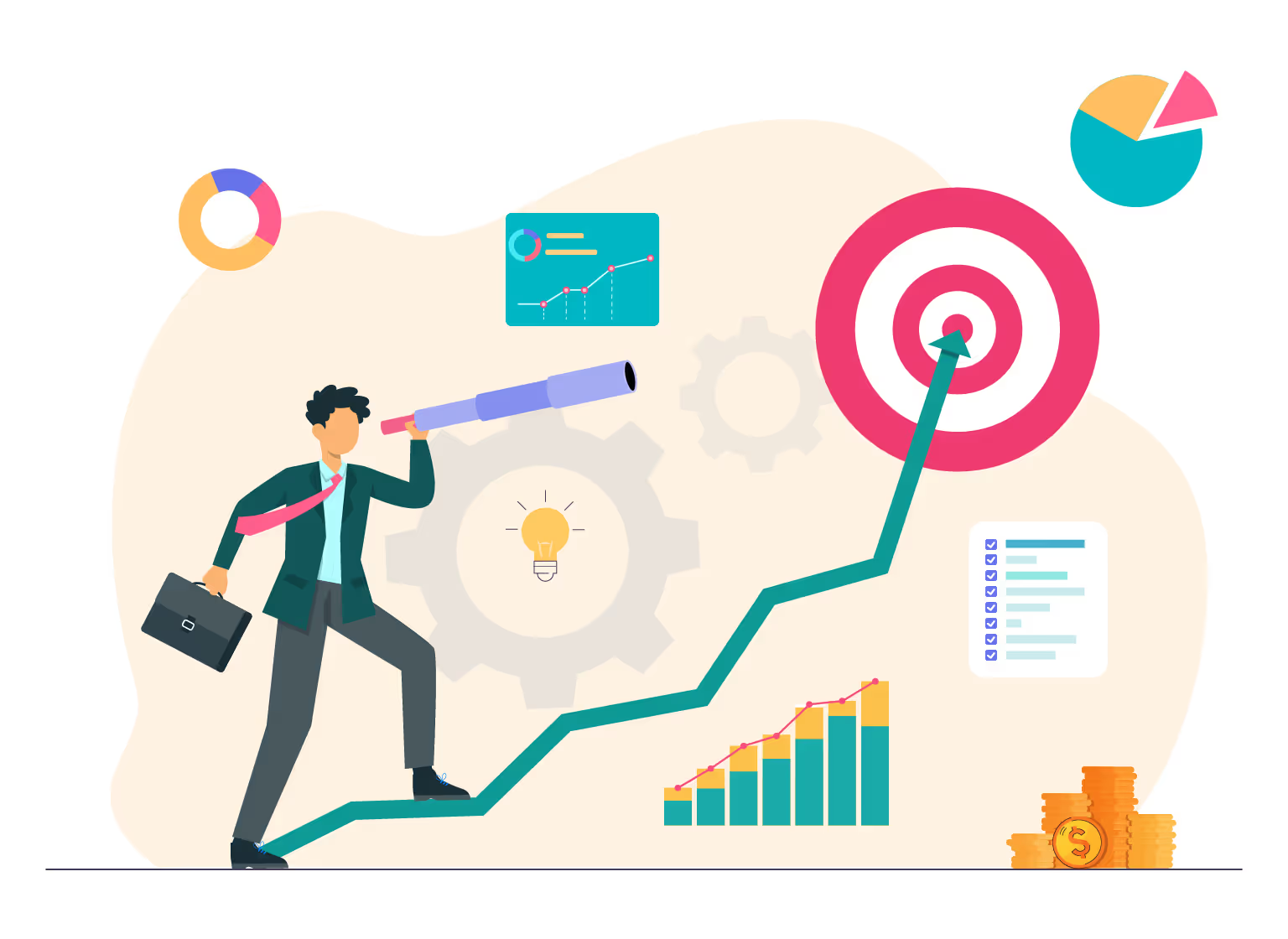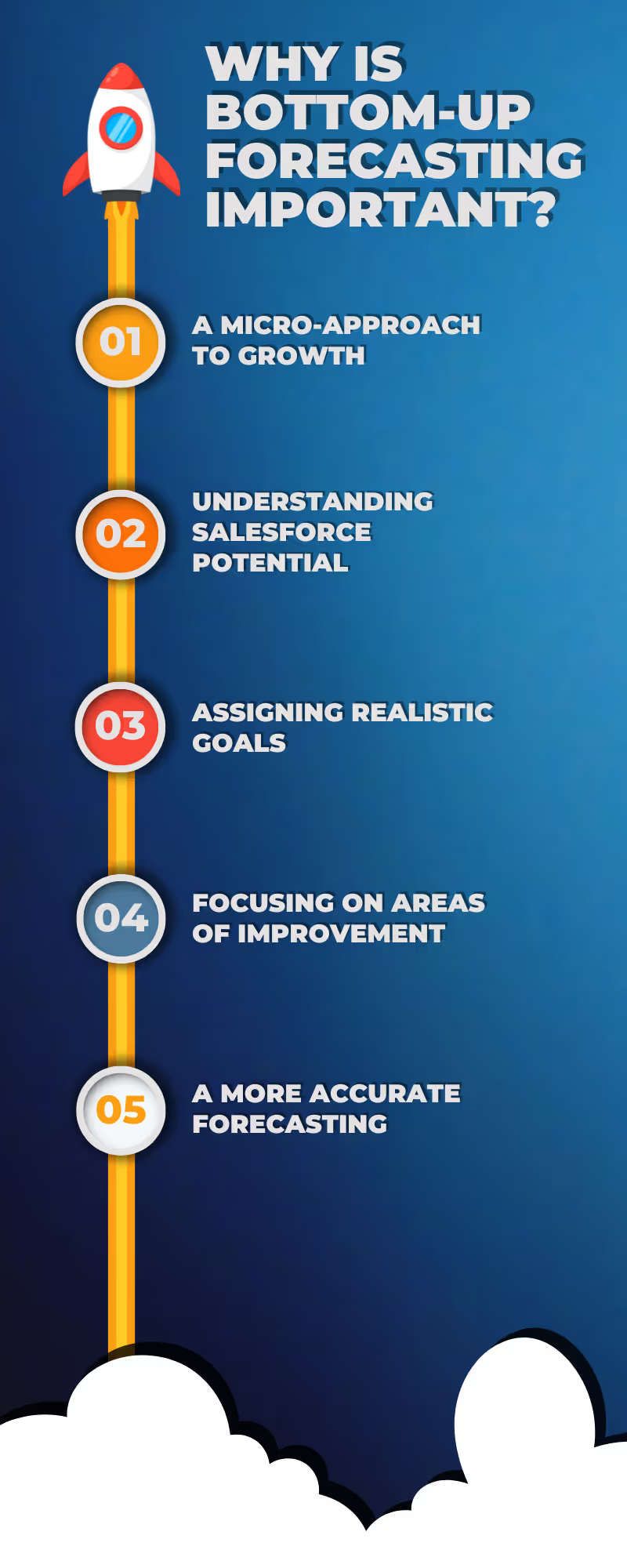
Blog
The Ultimate Guide to Maximize Accuracy with Bottoms Up Forecast
June 8, 2023


Key Insights
Having an understanding of how the year is going to turn out is crucial in business operations in general and sales in particular.
Organizations strive to forecast their sales to plan out a sales pipeline, strategies, and processes for the year.
But how easy is it to achieve them as charted out at the beginning of the year? With top-down and bottom-up forecasting available, how close are these approaches closer in reality? Among the two approaches, why does bottom-up forecasting stand as preferred?
Let's find answers to these questions in this article.
What is the Bottom-up Forecast?
Bottom-up forecasting is an approach to predicting sales by analyzing the lowest details of company operations. A bottom-up forecast looks into the product, salesforce, resources, budget, and many other factors revolving around the internal functions of the company.
Bottom-up forecasting is calculated using the formula
Revenue= Price x Quantity
The bottom-up approach is a practical way of business forecasting that offers several advantages to the salesforce and the organization.
Here are a few.
Why is Bottom-up Forecasting Important?

- A micro-approach to growth
The bottom-up forecast takes a micro-approach to growth. This means they look into every aspect of the organization at the base level. They understand the available resources, the budget, the current operation of the business, etc, before forecasting the agendas and targets for the year.
- Understanding salesforce potential
The bottom-up approach is very much considerate of the salesforce. It looks into the historical performance of each salesperson and their potential to strive more before assigning sales quotas for the period. This ensures that the salesforce is motivated to make the best use of their talent to achieve targets and not feel overburdened by it.
- Assigning Realistic Goals
As mentioned, a bottom-up forecast understands the ground reality. It knows the current condition and what effort will help reach the company to expected growth. With these realizations, management will only plan goals that are realistic to their current condition and attainable with their present efforts.
- Focusing on areas of improvement
Knowing what the bottom status is will also help understand the areas of improvement. Rectifying the setbacks and mistakes at the bottom level itself will create a strong foundation upon which plans can be constructed with strength.
- A more accurate forecasting
As a forecasting approach that understands the ground reality and plans for the future, the bottom-up approach is accurate forecasting, including considerations for "financial forecast vs projection." It understands the availability of resources, plans out a growth process based on it, and achieves it as well. It doesn't look at the organizational operations from a comprehensive overview and assign quotas to fulfill but works with goals grounded in reality.
How Bottom-up Forecast is Used

As an approach that closely analyzes the ground reality, the bottom-up forecast helps attain growth and targets effectively. So here are a few ways bottom-up forecasts are used in the everyday operations of business management, and incorporating a sales forecast calculator can streamline and enhance the accuracy of this granular approach by leveraging advanced analytical tools.
- Keeping track of the inventory
Bottom-up forecasting looks into each and every aspect of the everyday operations of the company. Especially the inventory that contains data about the products or services. As an approach that understands the availability of resources before charting the goals, it will ensure that products are never out of stock and enough in number to meet the expected requirements without wastage.
- Find Cost-effective Methods
As mentioned above the bottom-up knows the reality of the organization. Hence every plan and strategy will be planned closely aligning the financial status of the organization. This way they can make judicious use of the budget and resources without causing extra monetary requirements or wastage.
- Effective marketing campaign
The bottom-up analysis knows the availability of resources, growth the organization is striving to achieve, and what demands revolve around making these ends meet. Hence, integrating proven sales methodology examples into a bottom-up forecast will also help strategize effective marketing campaigns that ensure that the assigned quotas and targets are achieved with the available resources and manpower.
- Chart out the incentive program
Bottom-up forecasting is considered an accurate forecasting. Hence, from the beginning management knows the level of sales performance that is expected from the salesforce and their potential to achieve their quotas. This means that businesses can chart out an effective sales compensation plan that can be rewarded to eligible salespeople upon achieving their targets as promised without due.

Bottom-up vs Top-down Forecasting
We have talked immensely about bottom-up forecasting, its importance, uses, and benefits.
But what about top-down forecasting?
The top-down approach looks at the business operations from a comprehensive overview by understanding the market growth and trends. It charts out the responsibilities and goals of each department with an expectation to achieve the larger goal.
Top-down forecasting also requires intense research and analysis on the market, understanding its trends and what attracts people's attention, and what improves sales. It also requires a meticulous division of duties and responsibilities to effectively implement it in the company operations and find growth and success, a process particularly crucial in BDR sales where accurate forecasting informs proactive lead generation and strategic business development initiatives.
Takeaway
When weighing between bottom-up and top-down forecasting approaches to selling, there is no final answer as to which one is better than the other. It is a very subjective decision based on the company structure, its operations, its workforce, performance, budget, resources, and other factors.
Whichever approach you take up for your organization, the process is important in determining various aspects of your business operations. These also include sales territory management, incentive compensation management and sales performance management.
To know more about effective ways to manage your sales compensation plan, Book A Demo with Kennect.
ReKennect : Stay ahead of the curve!
Subscribe to our bi-weekly newsletter packed with latest trends and insights on incentives.
Thank you! Your submission has been received!
Oops! Something went wrong while submitting the form.
Your data is in safe hands. Check out our Privacy policy for more info




.avif)

.jpg)
.avif)







